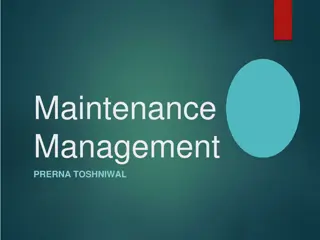Understanding Different Types of Maintenance Strategies
Maintenance department reports are crucial documents that provide insights into inspection tasks and their impact on overall operations. Unplanned maintenance occurs unexpectedly due to breakdowns, while planned maintenance is scheduled to minimize downtime. Types of maintenance include preventive, corrective, predictive, and proactive strategies aimed at maintaining equipment reliability and reducing downtime risks.
Download Presentation

Please find below an Image/Link to download the presentation.
The content on the website is provided AS IS for your information and personal use only. It may not be sold, licensed, or shared on other websites without obtaining consent from the author. Download presentation by click this link. If you encounter any issues during the download, it is possible that the publisher has removed the file from their server.
E N D
Presentation Transcript
MAINTENANCE DEPARTMENT REPORT
Maintenance department report Maintenance department report A maintenance report is a document that holds specific data about inspections and tasks as well as their effects on overall maintenance operations. You use them to gain visibility on your operations, which you can then leverage into better decision-making.
1) UNPLANNED MAINTENANCE 1) UNPLANNED MAINTENANCE Unplanned maintenance is maintenance that is carried out unexpectedly, without a formal schedule. This type of maintenance is usually the result of an unexpected breakdown. 2) PLANNED MAINTENANCE Planned maintenance refers to any maintenance activity that is planned, documented, and scheduled. The aim of planned maintenance is to reduce downtime by having all necessary resources on hand, such as labour and parts, and a strategy to use these resources.
TYPES OF MAINTENANCE TYPES OF MAINTENANCE a) PREVENTIVE MAINTENANCE The preventive maintenance is a schedule of planned maintenance actions aimed at the prevention of breakdowns and failures. The primary goal of preventive maintenance is to prevent the failure of equipment before it actually occurs. It is designed to preserve and enhance equipment reliability by replacing worn components before they actually fail. b) CORRECTIVE MAINTENANCE Corrective maintenance occurs when a maintenance technician discovers a problem while completing a preventive maintenance inspection, general, or emergency work order. Corrective maintenance identifies, isolates, and rectifies a fault so that the equipment, machine, or system can be restored to its original condition.
TYPES OF MAINTENANCE TYPES OF MAINTENANCE C) PREDICTIVE MAINTENANCE Predictive maintenance is a technique for doing maintenance by changing components based mostly on predictions utilizing a instrument. The point is that if the preventive methodology is barely based mostly on the schedule, then the predictive methodology relies on the results of the measurement. D) PROACTIVE MAINTENANCE Proactive maintenance is a maintenance strategy that aims to identify and fix the reasons for equipment failure before it happens. The goal of proactive maintenance is to increase asset reliability and reduce the risk of downtime. Wear and tear is a normal part of equipment lifecycles.
TYPES OF MAINTENANCE A) BREAKDOWN MAINTENANCE Breakdown maintenance is maintenance performed on equipment that has broken down and is unusable. It is based on a breakdown maintenance trigger. It may be either planned or unplanned.
Importance of maintenance report Importance of maintenance report 1) Reduces equipment failure and unplanned downtime. This is one of the top reasons why organizations focus on maintenance management. 2) Extends equipment's longevity. 3) Helps with workplace safety. 4) Helps keep costs under control. 5) Improves equipment efficiency. THINGS TO INCLUDE IN A MAINTENANCE REPORT Proper organization is crucial when creating a customer maintenance report for your business. While the specific items will depend on the needs of your company, six staples should always be present in every report that you make.
a) Category Maintenance managers and engineers should always assign a category to each maintenance activity. This will help keep track of the different types of maintenance tasks being carried out. Categories can include preventative maintenance, emergency maintenance, or corrective maintenance. b) Location Along with the type of maintenance being performed, your report should also allow users to document where the maintenance took place. This information is important for keeping track of maintenance activities in different parts of your facility. c) Date and Time Another essential piece of information to include in your maintenance report is the date and time that the maintenance was carried out. This information will help you keep track of when each maintenance task was completed.
d) Description Your maintenance report should also include a description of the maintenance activity carried out. The description should briefly summarize what was done during the maintenance task. However, it should also be detailed at the same time. Elaborate enough so that someone reading the maintenance report will understand what was done, but don t include so much information that it becomes overwhelming. e) Pictures Images can also be a valuable addition to your maintenance report. They can help document the condition of equipment before and after maintenance activities have been carried out. At the same time, pictures also prove that the maintenance task was actually completed. f) Signature The last thing to include in your maintenance report is a signature from the maintenance manager or engineer who completed the task. This will help to ensure that the maintenance report is accurate and complete.
BENEFITS OF USING A MAINTENANCE REPORT Assists in maintaining reliability Improves maintenance planning Good recordkeeping Prevents unexpected breakdowns Helps to achieve maintenance goals Saves time and money HOW TO CREATE A MAINTENANCE REPORT FORM creating a maintenance report will depend on several factors, such as the size of your company, the type of maintenance tasks being carried out, and the frequency of maintenance. However, they all serve one purpose to keep an accurate record of maintenance activities.
1. Choose a reporting format 2. Identify the elements that should be included 3. Create the report 4. Review the report
CONCLUSIONS Maintenance management is a key part of keeping teams productive. By ensuring that equipment is well-maintained, resources are used effectively, and everyone is working towards a common goal, maintenance management can help to improve a team's productivity.























